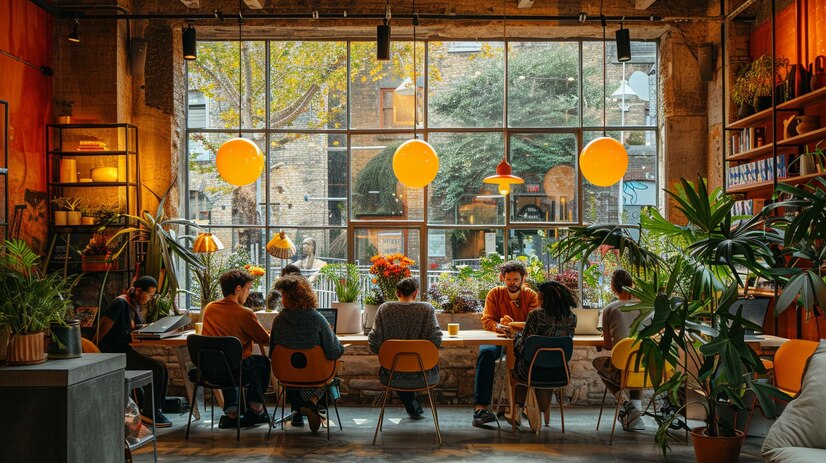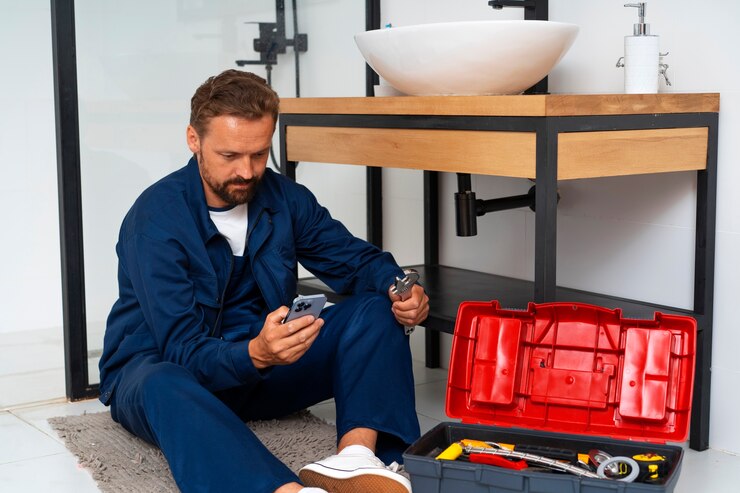HOME IMROVEMENT
How Innovative Designs Are Transforming Coffee House Ambiance

Introduction to Ambiance in Coffee Houses
Stepping into a coffee house is more than just about savoring a cup of coffee—it’s about indulging in the ambiance surrounding you. The unique combination of design elements and sensory experiences often defines a memorable visit. Attention to design detail invariably transforms spaces into experiences that captivate locals and travelers alike, proving to be a magnificent draw for anyone seeking coffee and a place to unwind.
The concept of ambiance in coffee houses has evolved from a mere afterthought to a strategic element of their identity. Amidst the hustle and bustle of everyday life, a welcoming atmosphere provides a sanctuary where individuals can relax or engage in social activities. Transforming ordinary cafés into inviting spaces requires carefully balancing design, functionality, and customer-focused features. It’s not just about aesthetics but bridging comfort with creativity to set the tone for social interaction. This increasingly determines the competitive edge for cafes, constantly seeking innovative ways to attract and retain customers by offering something unique.
The Importance of Design in Enhancing Customer Experience
The design within coffee houses significantly impacts customer perceptions and experiences. When executed thoughtfully, a well-designed space can render a venue inviting and comfortable, encouraging more extended patron visits and fostering a sense of community. Design influences first impressions; customers are drawn to spaces that radiate warmth and individuality. When you think of spaces with aesthetic appeal, new and unique environments, such as those offering New Construction Homes in the Southampton, come to mind because of their thought-out and innovative designs that capture the hearts of visitors. The role of design extends beyond visual appeal, enveloping subtle psychological triggers that encourage relaxation and socialization. Elements such as layout, color schemes, and furniture selection play vital roles in shaping experiences. According to modern design trends, even minor adjustments like lighting or seating arrangement can substantially impact customer satisfaction, turning sporadic customers into loyal patrons looking forward to their next visit.
Trending Design Elements for a Modern Look
In contemporary coffee houses, specific design trends are becoming increasingly popular, reflecting their clientele’s evolving tastes and expectations. Minimalism, marked by clean lines and uncluttered spaces, offers a tranquility that many find appealing amidst urban chaos. Using neutral color palettes paired with strategic splashes of color can invigorate a space, making it feel cozy and fresh. Industrial elements such as exposed brick, steel beams, and concrete details offer a modern yet rustic charm, blending urban sophistication with homely warmth. Incorporating natural materials—like reclaimed wood for tabletops or bamboo flooring—helps create an organic and earthy atmosphere, enhancing the authenticity and allure of the space.
These design elements do more than beautify a coffee house; they create an intimate relationship between the environment and visitors. They tell stories of sustainability and creativity, bridging traditional craftsmanship with contemporary design. Adapting these trends allows coffee houses to quickly transition from simple service shops into stimulating hangouts that encourage interaction and productivity. As the saying goes, the devil lies in the details, and nowhere is this more accurate than within the eclectic mix of modern cafes.
The Role of Sensory Experiences
The nuanced art of crafting a coffee house ambiance extends well into sensory experiences, creating a multipronged approach that captures patrons’ hearts and minds. Elements like lighting profoundly influence the environment’s mood, from the gentle embrace of natural daylight pouring through expansive windows to the intimate glow provided by low-hanging pendant lamps. The aroma of freshly brewed coffee acts like an invisible beacon, arousing senses and setting the scene for a warm gathering.
Soundscapes, too, enhance ambiance. Carefully chosen playlists foster an atmosphere that complements the ambiance, whether lively chatter over a steaming cup or concentrated work sessions. Studies have shown that crafting multi-sensory environments can significantly enhance customer satisfaction by seamlessly engaging different senses. These carefully designed sensory cues make patrons feel welcomed and appreciated, creating a holistic experience transcending the ordinary coffee cup.
Integrating Technology in Design
Modern technology integration fosters an enriched experience by making coffee houses more functional and accessible than ever. Technology enhances aesthetic innovation and operational efficiency, from intelligent lighting systems that adjust to the time of day for optimal comfort to automated espresso machines that ensure consistent quality. Digital menu boards streamline the ordering process, while wireless charging stations offer convenience for tech-savvy individuals constantly on the go.
By utilizing technology, cafes can offer personalized features that cater to individual preferences, such as interactive displays that allow patrons to customize their orders or loyalty programs that reward return visits. This seamless blend of innovation and practicality elevates the experience and creates an atmosphere that resonates with a tech-oriented audience eager to entwine their lifestyle with modern conveniences.
Sustainability in Coffee House Design
With growing environmental awareness, sustainability is firmly rooted in coffee house design practices. An increasing number of patrons value eco-conscious choices businesses make, reflecting an ethical alignment with their values. The selection of eco-friendly materials—be it recycled metals, sustainably sourced woods, or energy-efficient lighting solutions—is no longer seen as optional but as essential in the eyes of conscientious consumers.
Sustainable furniture, solar panels, and green walls are additional features that harmonize nature with design, emphasizing a coffee house’s commitment to sustainability. Articles in sustainable design resources highlight how sustainable practices can seamlessly align with innovative design efforts, rendering coffee spaces attractive while reducing environmental footprints. By embracing sustainability, coffee houses contribute positively to the environment and build stronger connections with their patrons who prioritize eco-friendliness.
Real-Life Examples of Innovative Coffee Houses
Across the globe, coffee houses are emerging as testaments to innovation and creativity, showcasing how design can transform ordinary spaces into remarkable experiences. In Berlin, for example, one coffee house has implemented a living green wall that serves as a centerpiece of beauty and a natural air purifier, enhancing the quality of the environment for both staff and patrons. A café in Japan has redefined social interaction with its dynamic seating arrangements, encouraging conversation through shared tables and offering private nooks for those desiring solitude.
These examples exemplify how thoughtful design and innovative concepts can turn a space into more than just a coffee-serving venue. They become community gathering spots, drawing individuals together through shared interests in relaxation, creativity, and connection. Through these creative approaches, coffee houses set a benchmark for excellence in design, offering life and vibrancy to urban landscapes.
Future Trends in Coffee House Design
The future of coffee house design seems boundless as creativity meets functionality, guided by evolving consumer preferences and technological advancements. Emerging trends suggest a movement towards more adaptive and flexible designs that accommodate various social and professional activities, creating hybrid spaces that cater simultaneously to the needs of leisure seekers and digital nomads. The emphasis on sustainability will persist, accompanied by increased interest in holistic approaches encompassing everything from materials used to customer service practices.
Moreover, augmented reality experiences appear poised to revolutionize the traditional coffee house setup, with interactive displays and virtual extensions enriching the customer’s journey. The flexibility and adaptability inherent in future trends promise enriching transformations across coffee houses, ushering in new dimensions of customer engagement and redefining urban spaces into hubs of innovation and connection. As design continually reinvents itself, coffee house venues will thrive as dynamic settings that inspire creativity and foster genuine connections.
HOME IMROVEMENT
Why Real Estate Agents Are Key to a Stress-Free Home Purchase

Real estate brokers’ knowledge is quite helpful when buying a house. From comprehending market trends to negotiating rates, they provide guidance at every stage of the process. Their knowledge helps clients navigate complex documentation while guaranteeing that all legal and financial matters are taken care of. A good agent is knowledgeable about the local market, which helps find the right property at the right price. This guidance can reduce stress and make the entire experience smoother.
Syracuse UT real estate agents Doxey Real Estate Group exemplify how an experienced agent can ease the home-buying journey. With their in-depth knowledge of the area and understanding of buyers’ needs, they can help you find the perfect home and ensure all aspects of the deal are handled professionally. Their expertise ensures that your purchase is not only successful but also stress-free.
Local Knowledge and Insights
Every village has a unique charm that is frequently only noticed by locals. Real estate brokers are a great resource when it comes to learning how a community is vibrant and fits your requirements. Agents offer vital information beyond simple real estate listings, from in-depth familiarity with school areas to recommendations for excellent cafés and public parks.
Additionally, agents offer clear, practical guidance on assessing market conditions. This critical information helps you understand property values and market dynamics, reinforcing sound decision-making.
Handling Offers and Negotiations
Creating the perfect bid is both an art and a science, honed through experience and strategic acumen. Agents offer expertise in this delicate process, crafting personalized offers that adhere to your budget yet stand out in a competitive landscape. They engage with sellers using finely tuned tactics, advocating for favorable terms that ensure your investment is sound and secure.
Understanding the intricacies of a purchase offer—including contingencies like home inspections, financing conditions, and timelines—demands experience. Agents walk you through these critical components, enhancing your negotiation power and protecting your financial interests. Their guidance is aimed not merely at closing a deal but securing a home under terms that leave you comfortable and confident.
Agents Navigate the Paperwork
There is a lot of documentation involved in real estate transactions. Every document, from early proposals to final closing agreements, has potential difficulties and calls for specific processes. Working with an agent guarantees that all documentation is prepared and filed on time to prevent errors that can compromise your acquisition.
Agents are essential because they explain each document’s importance and ensure that your interests are fully protected throughout the process.
Providing Emotional Support
The emotional journey of purchasing a home can be just as complex as the logistical one. As you’re engulfed in an array of emotions—from excitement to anxiety—having an empathetic advisor by your side can be invaluable. Real estate agents often find themselves as guides and counselors, offering reassurance and a calming presence during turbulent times.
Their support extends to helping you maintain perspective and encouraging rational decision-making even when faced with setbacks or difficult choices. This emotional support is integral to keeping your focus on long-term aspirations rather than immediate obstacles.
The Power of Professional Networks
By working with a real estate agent, you’re gaining an expert advisor and access to an entire network of professionals. From inspections and appraisals to financing and relocation services, agents can recommend trusted providers, ensuring that each phase of your home purchase is handled with precision and care.
These relationships within the industry save you countless hours of vetting and provide assurances of quality and reliability—key elements that can significantly alleviate the stresses often associated with managing so many moving parts simultaneously.
Your Partner in a Stress-Free Transaction
Ultimately, a relationship with a real estate agent is a partnership built on trust. By deeply understanding your aspirations and working tirelessly to transform them into reality, they mitigate the everyday stresses of buying a home. Their mission is as much about securing a home as providing a seamless experience that allows you to enjoy every step of this momentous journey.
With an agent’s guidance, the often daunting process of home buying becomes an exciting adventure—one that leads to a future filled with possibilities and the satisfaction of securing a place you’ll proudly call home.
HOME IMROVEMENT
Top Problems with Pump Down Perforating and How to Fix Them

A fundamental method in the oil and gas sector, pump-down perforating makes connecting the wellbore to the nearby reservoir easier. Despite its critical role, this process often encounters challenges that can impact efficiency and effectiveness. Understanding the common problems associated with pump-down perforating and their solutions is essential for maintaining optimal performance and achieving project goals.
Common Problems and Solutions in Pump Down Perforating
Inadequate Wellbore Cleaning
One of the primary challenges in pump-down perforating is ensuring sufficient wellbore cleaning. Debris and blockages can hinder the perforating equipment, leading to inefficient operations and an increased risk of tool sticking. Regular cleaning procedures should be integrated into the planning phase to mitigate this issue. In cases where this is not a viable solution, enlisting professionals specializing in cleaning and logistics can significantly improve the outcome. For instance, experts like Renegade Services can use advanced techniques and tools to clear obstructions effectively and ensure the smooth running of perforating operations.
Tool Failures and Mechanical Issues
Tool failures and mechanical malfunctions are frequently encountered during pump-down perforating projects. These issues may arise due to wear and tear or improper equipment handling. Implementing a robust maintenance routine for all equipment can help prevent such occurrences. Regular inspections and prompt repairs or replacements of worn-out components will minimize downtime and ensure seamless operations.
Pressure Control Challenges
Maintaining appropriate pressure levels during perforating is crucial for achieving optimal results. Inadequate pressure control can lead to suboptimal perforation or even damage to the reservoir. Operators should focus on precise pressure monitoring and control systems, possibly incorporating automated pressure regulation technologies. Engaging professionals with pressure management expertise can also ensure the process remains controlled throughout the operation.
Communication Breakdowns
Effective communication is vital for coordinating complex pump-down perforating tasks. Communication breakdowns can result in operational delays and safety risks. To mitigate this issue, ensure all team members are equipped with reliable communication tools and train them on communication protocols. Moreover, professionals can liaise between different teams, providing clarity and aligning goals and actions across the project.
Inaccurate Perforation Placement
Precise perforation placement is essential for maximizing productivity and reservoir contact. Errors in perforation placement can reduce efficiency and increase operational costs. Advanced imaging and mapping technologies can assist in accurately determining the optimal perforation points. Furthermore, hiring professionals who deeply understand geological formations and reservoir characteristics can enhance placement accuracy, resulting in improved performance.
The Value of Professional Expertise
Professionals bring invaluable experience and knowledge to pump down perforating projects. Their ability to quickly identify issues and implement effective solutions ensures operations remain on track. By leveraging expert insights, operators can optimize processes, prevent costly downtime, and enhance project outcomes. Moreover, professionals can provide recommendations tailored to the specifics of a given project for improving efficiency and safety.
While essential, pump-down perforating is not without its challenges. By understanding and addressing the common problems associated with this process, operators can ensure smoother operations and better results. Proper maintenance routines, precise pressure control, and effective communication are key strategies for overcoming these challenges. Additionally, utilizing professional expertise can significantly improve the efficacy and safety of pump-down perforating projects, ultimately leading to a more productive and cost-effective outcome.
-

 BLOG12 months ago
BLOG12 months agoBebasIndo: Transforming Service Accessibility Across Indonesia
-

 TECH12 months ago
TECH12 months agoLepbound: Unlocking the Hidden Power of Optimization in Science and Technology
-

 ENTERTAINMENT12 months ago
ENTERTAINMENT12 months agoDiamond Pink: A Rare Gem, A Precious Possession
-

 BUSINESS11 months ago
BUSINESS11 months agoChannelsyncharma: Your Guide to Effective Channel Management
-

 BUSINESS11 months ago
BUSINESS11 months agoQuick Relief with Immediate 0.3 Folex
-

 TECH12 months ago
TECH12 months agoGirma Zekpa: An Influential Figure in Business and Technology
-

 NEWS12 months ago
NEWS12 months agoSo Ji-Sub LPSG: From Model to Star, the Evolution of a Korean Icon
-

 HEALTH11 months ago
HEALTH11 months agoCarson Dennis Dentist Orthodontics Navy HPSP: A Comprehensive Guide
